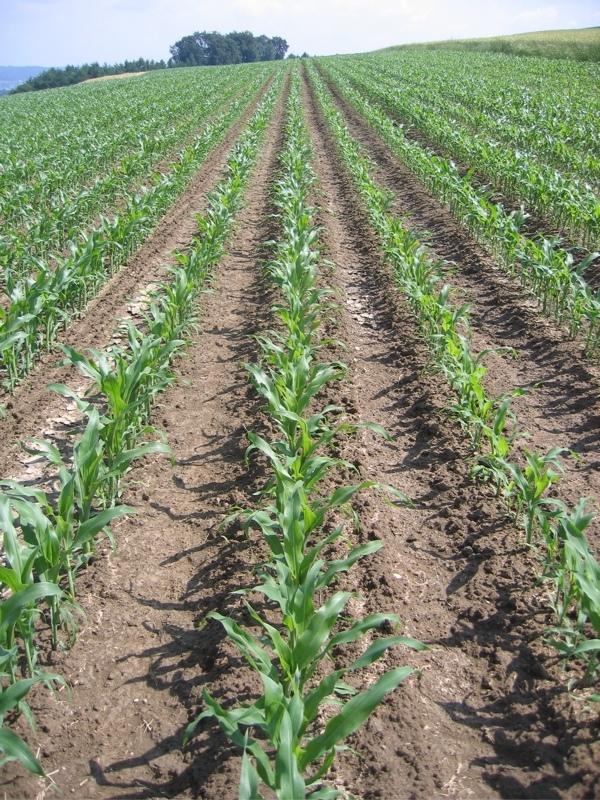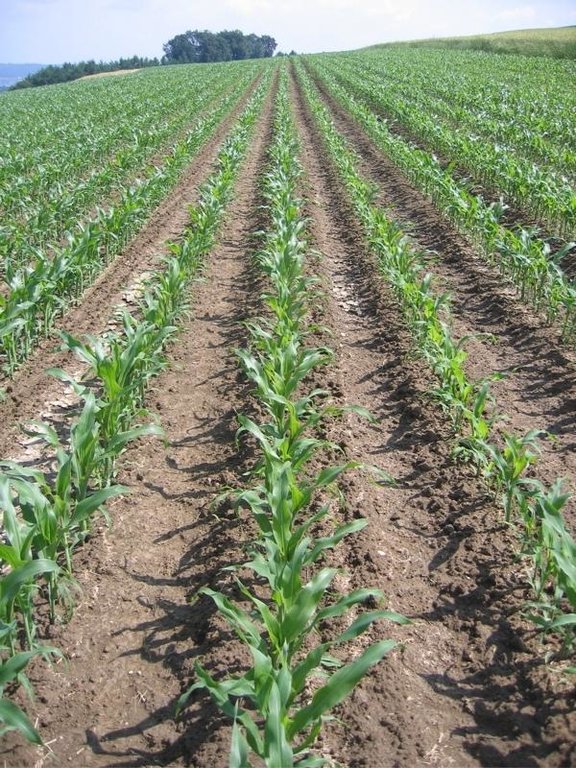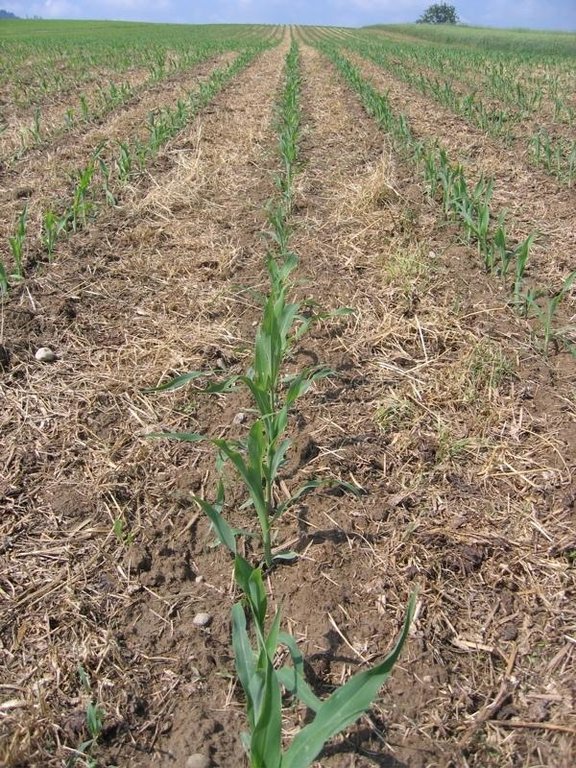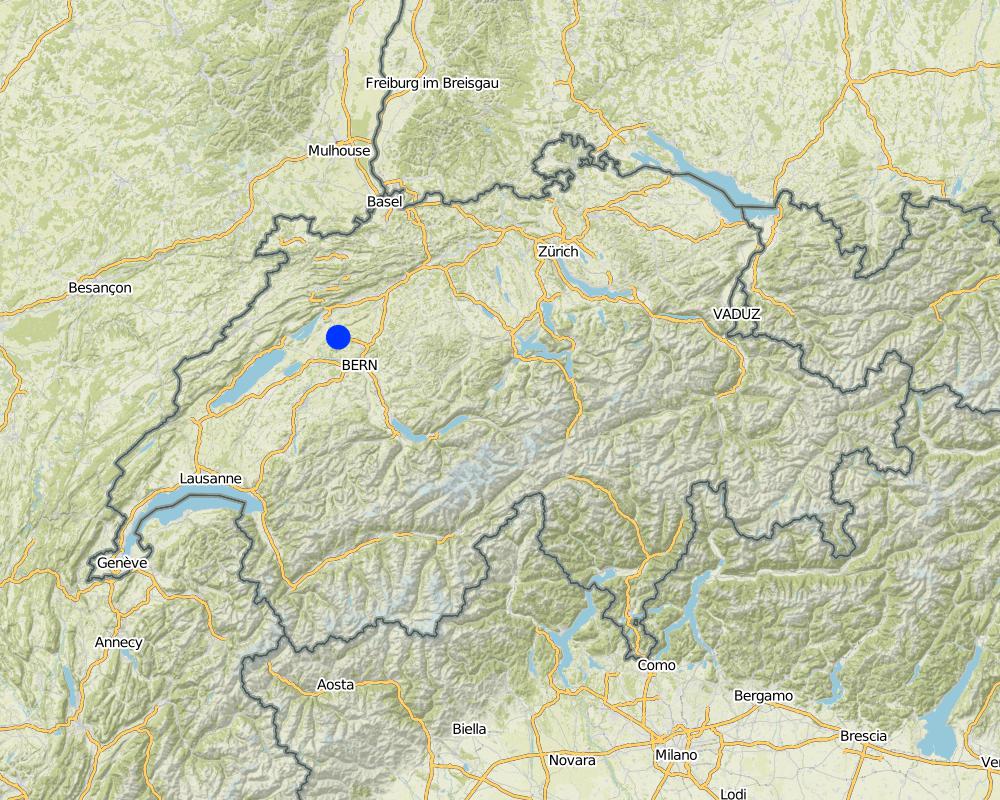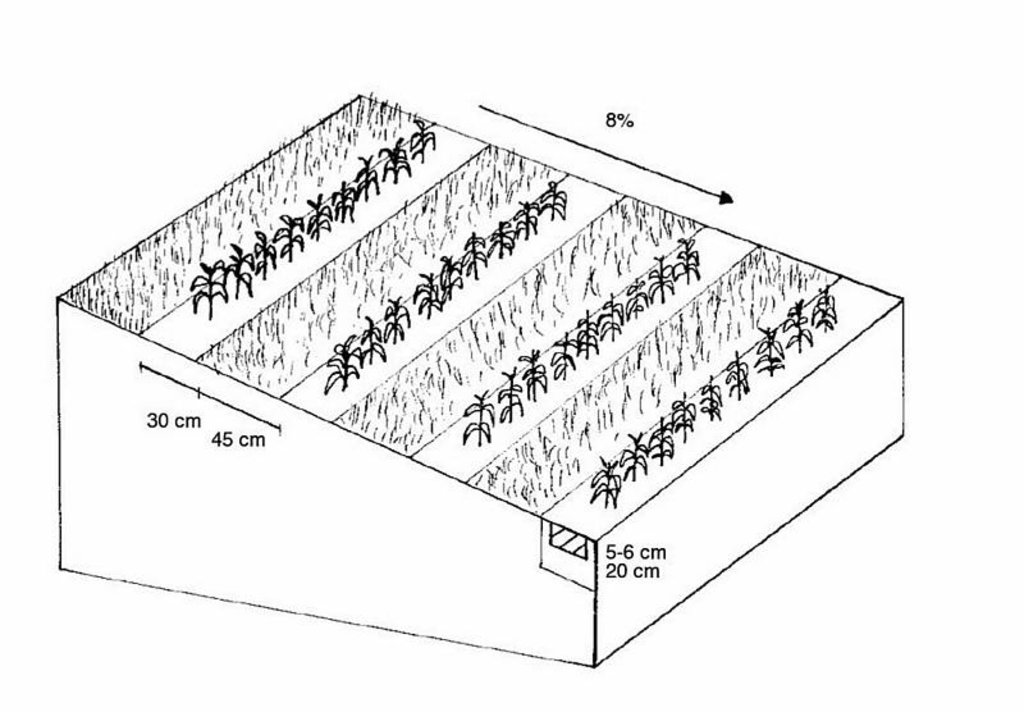Maize strip tillage [Suisse]
- Création :
- Mise à jour :
- Compilateur : Unknown User
- Rédacteur : –
- Examinateurs : Fabian Ottiger, Alexandra Gavilano
Streifenfrässaat
technologies_1008 - Suisse
Voir les sections
Développer tout Réduire tout1. Informations générales
1.2 Coordonnées des personnes-ressources et des institutions impliquées dans l'évaluation et la documentation de la Technologie
Personne(s)-ressource(s) clé(s)
Spécialiste GDT:
Buddeke Giulietta
Geographisches Institut der Universität Bern -GIUB
Suisse
exploitant des terres:
Friederich Jürg
Landwirtschaftliches Lohnunternehmen Seelandzenturm Suberg
Suisse
Nom du ou des institutions qui ont facilité la documentation/ l'évaluation de la Technologie (si pertinent)
Jürg Friederich Lohnunternehmung - SuisseNom du ou des institutions qui ont facilité la documentation/ l'évaluation de la Technologie (si pertinent)
University of Bern, Institute of Geography (GIUB) - Suisse1.3 Conditions relatives à l'utilisation par WOCAT des données documentées
Le compilateur et la(les) personne(s) ressource(s) acceptent les conditions relatives à l'utilisation par WOCAT des données documentées:
Oui
2. Description de la Technologie de GDT
2.1 Courte description de la Technologie
Définition de la Technologie:
Maize strip tillage is used for corn cultivation and the technology ensures that only those stripes are cultivated where seed is applied.
2.2 Description détaillée de la Technologie
Description:
Maize strip tillageis a soil conservation method used in crop production. First of all the grass in the area needs to be prepared by splattering round-up some 3-10 days in advance. Then the actual maize strip tillage machine carves a stripe and the seed are inserted within this 30 cm strip. At the same time fertilizer is added on these cultivated stripes. Between those cultivated stripes the mulch-grass stripes (45cm) are unmechanised and protect the soil by increasing its stability. Due to these mulch-stripes the matrix of the soil is more complex and therefore the stability is better especially during the harvest in September. The interviewed farmer said it was cause of the improved soil structure that his tractors are not subside and compaction is also less likely to occur. Another advantage is the decreased risk of soil erosion when having more and heavy precipitation, as it is expected for next decades due to climate changes in Switzerland. Thanks to the SLM technology, water infiltration increases and organic matter as well which adds up to a promising growth period.
There are also clear economic advantages, by adopting the technology. In springtime only one working step is needed for seeding compared to the five steps needed with the traditional technique using a plough. Therefore the costs are finally lower with this technology and farmers can use the opportunity when having free labour to work part-time outside the farm. At first sight, the costs might seem higher when adopting this technology cause the farmer needs to hire a subtractor, in the end the costs are lower due to the lower labour input and the lower equipment costs. After having seen the advantages, the interviewed farmer said that the technology is usually maintained.
A high level of knowledge about the natural condition is needed when adopting this technology. On the one hand, the farmer must time the date for seeding adequately to the natural conditions, it needs some 4 days with no precipitation. Then on the other hand, the farmer has to apply Glyphosphat after the seeding in order to guarantee an optimal growth period for the corn. The timing to start seeding with this technology may be later cause corn is sensitive towards rival plants, low temperatures and humidity. These are some of the limits that the technology implies. If springtime is humid, the farmer should be allowed to use the traditional technique, regardless of the subsidies as indicated by the interviewed farmer. The canton of Bern is providing subsidies if the farmer commits to use a five year cycle which inherits not to use the plough during this period but using a mulch system. The interviewed farmer suggests that the canton of Bern could commit itself not only in giving subsidies to the areas but also to support if contractors like him would get subsidies for the investment for machines that are needed. For a single farmer the establishment costs for the equipment are too high so that the average is hiring a contractor who could work for a lower salary when having support to buy machines, so subsidies from the Cantons would be an asset.
2.3 Photos de la Technologie
2.5 Pays/ région/ lieux où la Technologie a été appliquée et qui sont couverts par cette évaluation
Pays:
Suisse
Région/ Etat/ Province:
Bern
Autres spécifications du lieu:
Suberg
Spécifiez la diffusion de la Technologie:
- répartie uniformément sur une zone
S'il n'existe pas d'informations exactes sur la superficie, indiquez les limites approximatives de la zone couverte:
- 0,1-1 km2
Map
×2.6 Date de mise en œuvre de la Technologie
Si l'année précise est inconnue, indiquez la date approximative: :
- il y a moins de 10 ans (récemment)
2.7 Introduction de la Technologie
Spécifiez comment la Technologie a été introduite: :
- au cours d'expérimentations / de recherches
Commentaires (type de projet, etc.) :
Peter Hofer made different experiments wiht SLM Technologies and after successful implementation of maize strip tillage, idea was adopted
3. Classification de la Technologie de GDT
3.2 Type(s) actuel(s) d'utilisation des terres, là où la Technologie est appliquée

Terres cultivées
- Cultures annuelles
Cultures annuelles - Précisez les cultures:
- céréales - maïs
Nombre de période de croissance par an: :
- 1
Précisez:
Longest growing period in days: 150Longest growing period from month to month: Apr - Sep
Commentaires:
Major land use problems (compiler’s opinion): Soil erosion in hilly areas
Major land use problems (land users’ perception): Due to changed weather conditions, basically an increase of percipitation, soil erosion increased
Future (final) land use (after implementation of SLM Technology): Cropland: Ca: Annual cropping
3.5 Groupe de GDT auquel appartient la Technologie
- perturbation minimale du sol
- mesures en travers de la pente
3.6 Mesures de GDT constituant la Technologie

pratiques agronomiques
- A1: Couverture végétale/ du sol
Commentaires:
Main measures: agronomic measures
Type of agronomic measures: cover cropping, retaining more vegetation cover, mulching, manure / compost / residues, rotations / fallows, minimum tillage
3.7 Principaux types de dégradation des terres traités par la Technologie

érosion hydrique des sols
- Wt: perte de la couche superficielle des sols (couche arable)/ érosion de surface
- Wg: ravinement/ érosion en ravines

dégradation physique des sols
- Pc: compaction

dégradation biologique
- Bc: réduction de la couverture végétale
Commentaires:
Main type of degradation addressed: Wt: loss of topsoil / surface erosion
Secondary types of degradation addressed: Wg: gully erosion / gullying, Pc: compaction, Bc: reduction of vegetation cover
Main causes of degradation: crop management (annual, perennial, tree/shrub) (using a plough in hilly area increases soil erosion)
3.8 Prévention, réduction de la dégradation ou réhabilitation des terres dégradées
Spécifiez l'objectif de la Technologie au regard de la dégradation des terres:
- prévenir la dégradation des terres
- réduire la dégradation des terres
Commentaires:
Main goals: mitigation / reduction of land degradation
Secondary goals: prevention of land degradation
4. Spécifications techniques, activités, intrants et coûts de mise en œuvre
4.1 Dessin technique de la Technologie
Spécifications techniques (associées au dessin technique):
Technical knowledge required for field staff / advisors: high
Technical knowledge required for land users: moderate
Main technical functions: improvement of ground cover
Secondary technical functions: improvement of topsoil structure (compaction), increase in organic matter, increase of infiltration
4.2 Informations générales sur le calcul des intrants et des coûts
autre/ monnaie nationale (précisez):
Swiss Franc
Indiquez le taux de change des USD en devise locale, le cas échéant (p.ex. 1 USD = 79.9 réal brésilien): 1 USD = :
1,08
Indiquez le coût salarial moyen de la main d'œuvre par jour:
194.00
4.3 Activités de mise en place/ d'établissement
| Activité | Calendrier des activités (saisonnier) | |
|---|---|---|
| 1. | Buy a machine for technology |
Commentaires:
Number of parties sharing: 2
4.4 Coûts et intrants nécessaires à la mise en place
| Spécifiez les intrants | Unité | Quantité | Coûts par unité | Coût total par intrant | % du coût supporté par les exploitants des terres | |
|---|---|---|---|---|---|---|
| Main d'œuvre | applying round-up | ha | 1,0 | 97,0 | 97,0 | 100,0 |
| Main d'œuvre | maize strip tillage | ha | 1,0 | 388,0 | 388,0 | 100,0 |
| Equipements | Tools | ha | 1,0 | 56300,0 | 56300,0 | 100,0 |
| Coût total de mise en place de la Technologie | 56785,0 | |||||
| Coût total de mise en place de la Technologie en dollars américains (USD) | 52578,7 | |||||
Commentaires:
Duration of establishment phase: 2 month(s)
4.5 Activités d'entretien/ récurrentes
| Activité | Calendrier/ fréquence | |
|---|---|---|
| 1. | Applying round up on the field | 1 |
| 2. | Applying maize strip tillage | 1 |
| 3. | Add herbicide on field | 1 |
| 4. | Harvest of the corn | 1 |
4.6 Coûts et intrants nécessaires aux activités d'entretien/ récurrentes (par an)
Commentaires:
Establishment costs are estimated for the contractor on the one hand and labour costs indicated above are the ones that the contractor is demanding for if he is hired. Additionally, those farmers who adapt this technology can get subsidies from the Canton if he/she commits to apply soil conservating measurements during 5 years, in Bern it is 450 CHF per ha.
4.7 Facteurs les plus importants affectant les coûts
Décrivez les facteurs les plus importants affectant les coûts :
Labour costs and costs for diesel are much higher for the traditional technology (plough). The investment for the technology are high in the first term and the labour costs indicated above are given by the contractor if he is hired. So for a regular farmer only these 388 USD are relevant.
5. Environnement naturel et humain
5.1 Climat
Précipitations annuelles
- < 250 mm
- 251-500 mm
- 501-750 mm
- 751-1000 mm
- 1001-1500 mm
- 1501-2000 mm
- 2001-3000 mm
- 3001-4000 mm
- > 4000 mm
Spécifications/ commentaires sur les précipitations:
Tendency towards increased rainfall
Zone agro-climatique
- subhumide
Thermal climate class: temperate
5.2 Topographie
Pentes moyennes:
- plat (0-2 %)
- faible (3-5%)
- modéré (6-10%)
- onduleux (11-15%)
- vallonné (16-30%)
- raide (31-60%)
- très raide (>60%)
Reliefs:
- plateaux/ plaines
- crêtes
- flancs/ pentes de montagne
- flancs/ pentes de colline
- piémonts/ glacis (bas de pente)
- fonds de vallée/bas-fonds
Zones altitudinales:
- 0-100 m
- 101-500 m
- 501-1000 m
- 1001-1500 m
- 1501-2000 m
- 2001-2500 m
- 2501-3000 m
- 3001-4000 m
- > 4000 m
Commentaires et précisions supplémentaires sur la topographie:
Altitudinal zone: 101-1000 m a.s.l. (depending on the area)
5.3 Sols
Profondeur moyenne du sol:
- très superficiel (0-20 cm)
- superficiel (21-50 cm)
- modérément profond (51-80 cm)
- profond (81-120 cm)
- très profond (>120 cm)
Texture du sol (de la couche arable):
- moyen (limoneux)
Matière organique de la couche arable:
- moyen (1-3%)
Si disponible, joignez une description complète du sol ou précisez les informations disponibles, par ex., type de sol, pH/ acidité du sol, capacité d'échange cationique, azote, salinité, etc.
Soil fertility is medium
Soil drainage/infiltration is good
Soil water storage capacity is medium
5.4 Disponibilité et qualité de l'eau
Profondeur estimée de l’eau dans le sol:
5-50 m
Qualité de l’eau (non traitée):
eau potable
Commentaires et précisions supplémentaires sur la qualité et la quantité d'eau:
Availability of surface water: good, medium ( depending on the area )
Water quality (untreated): Good drinking water ( generally good quality of water )
5.5 Biodiversité
Diversité des espèces:
- moyenne
Commentaires et précisions supplémentaires sur la biodiversité:
depending on the area
5.6 Caractéristiques des exploitants des terres appliquant la Technologie
Revenus hors exploitation:
- 10-50% de tous les revenus
Niveau relatif de richesse:
- riche
Individus ou groupes:
- individu/ ménage
Indiquez toute autre caractéristique pertinente des exploitants des terres:
Difference in the involvement of women and men: Generally speaking, men tend to work on the fields therefore are mainly responsible for technologies, women tend to work in the houshold and are responsible for administrative tasks. In Switzerland there is a traditional labour division between men and women, there might be exceptions but if addressing new technology one has to deal with male farmers. Assuming that decisions to adapt new technologies or for investments are made by both.
Population density: 10-50 persons/km2
Annual population growth: < 0.5%
Off-farm income specification: For those farmers working off-farm it is likely to delegate work to contractor. On the other hand when hiring a contractor there is less labour needed for the farmer and the possibility to work off-farm slightly higher.
5.8 Propriété foncière, droits d’utilisation des terres et de l'eau
Propriété foncière:
- individu, sans titre de propriété
Droits d’utilisation des terres:
- communautaire (organisé)
Droits d’utilisation de l’eau:
- communautaire (organisé)
Commentaires:
Half of the land is leased and the other was bought by the farmer. He said there is a tendency towards land selling.
5.9 Accès aux services et aux infrastructures
santé:
- pauvre
- modéré
- bonne
éducation:
- pauvre
- modéré
- bonne
assistance technique:
- pauvre
- modéré
- bonne
emploi (par ex. hors exploitation):
- pauvre
- modéré
- bonne
marchés:
- pauvre
- modéré
- bonne
énergie:
- pauvre
- modéré
- bonne
routes et transports:
- pauvre
- modéré
- bonne
eau potable et assainissement:
- pauvre
- modéré
- bonne
services financiers:
- pauvre
- modéré
- bonne
6. Impacts et conclusions
6.1 Impacts sur site que la Technologie a montrés
Impacts socio-économiques
Production
risque d'échec de la production
Commentaires/ spécifiez:
Conditions need to be good, if season too wet, harvest can decrease
Revenus et coûts
dépenses pour les intrants agricoles
charge de travail
Autres impacts socio-économiques
Use of pesticides
Commentaires/ spécifiez:
Consequences of using pesticide are not known yet, traces in drinking water might be likely to occure
Impacts socioculturels
connaissances sur la GDT/ dégradation des terres
apaisement des conflits
Impacts écologiques
Cycle de l'eau/ ruissellement
ruissellement de surface
Sols
perte en sol
matière organique du sol/ au dessous du sol C
Biodiversité: végétale, animale
espèces étrangères envahissantes
Commentaires/ spécifiez:
More crows are on the fields after seeding
contrôle des animaux nuisibles/ maladies
Autres impacts écologiques
Infiltration
6.3 Exposition et sensibilité de la Technologie aux changements progressifs et aux évènements extrêmes/catastrophes liés au climat (telles que perçues par les exploitants des terres)
Changements climatiques progressifs
Changements climatiques progressifs
| Saison | Augmentation ou diminution | Comment la Technologie fait-elle face à cela? | |
|---|---|---|---|
| températures annuelles | augmente | bien |
Extrêmes climatiques (catastrophes)
Catastrophes météorologiques
| Comment la Technologie fait-elle face à cela? | |
|---|---|
| pluie torrentielle locale | bien |
| tempête de vent locale | pas connu |
Catastrophes climatiques
| Comment la Technologie fait-elle face à cela? | |
|---|---|
| sécheresse | bien |
Catastrophes hydrologiques
| Comment la Technologie fait-elle face à cela? | |
|---|---|
| inondation générale (rivière) | pas connu |
Autres conséquences liées au climat
Autres conséquences liées au climat
| Comment la Technologie fait-elle face à cela? | |
|---|---|
| réduction de la période de croissance | pas bien |
Commentaires:
With the grass stripes between the corn rows, the water can infiltrate faster and the soil is more stable and protected. The technology can be more tolerant towards intensive rainfalls but only to a certain extent. The technology is more sensitive when having humid conditions in spring and problems can occure then when trying to apply the stripe mill cropping..
6.4 Analyse coûts-bénéfices
Quels sont les bénéfices comparativement aux coûts de mise en place (du point de vue des exploitants des terres)?
Rentabilité à court terme:
négative
Rentabilité à long terme:
positive
Quels sont les bénéfices comparativement aux coûts d'entretien récurrents (du point de vue des exploitants des terres)?
Rentabilité à court terme:
légèrement positive
Rentabilité à long terme:
positive
6.5 Adoption de la Technologie
Commentaires:
35% of land user families have adopted the Technology with external material support
Comments on acceptance with external material support: When having good experiences with technology, some 80-90% of the farmers are maintaining this technology
6.7 Points forts/ avantages/ possibilités de la Technologie
| Points forts/ avantages/ possibilités du point de vue de l'exploitant des terres |
|---|
|
less workload How can they be sustained / enhanced? Farmers should estimate their own labour time as well and then compare the costs of traditional technology and the SLM technology |
|
less costs How can they be sustained / enhanced? In the long-term costs for a farmer decrease by a third. Less diesel costs are needed. |
|
less erosion How can they be sustained / enhanced? Subsidies of the cantons could ensure that farmers adapt technology, therefore enhance their knowledge about soil erosion and the costs. |
| Points forts/ avantages/ possibilités du point de vue du compilateur ou d'une autre personne ressource clé |
|---|
|
reduction of soil erosion How can they be sustained / enhanced? Enhancing knowledge about soil erosion |
|
improvement of soil structure How can they be sustained / enhanced? Enhancing knowledge by experiments shown to farmers |
6.8 Faiblesses/ inconvénients/ risques de la Technologie et moyens de les surmonter
| Faiblesses/ inconvénients/ risques du point de vue de l’exploitant des terres | Comment peuvent-ils être surmontés? |
|---|---|
| Timing is needed | Enhance knowledge about technology when conditions are too wet, farmers should be allowed to use plough instead of SLM technology |
| Subsidies only for areas | Canton could subsidies/support if contractor or farmer invests in a machine used for strip mill cropping. 5 years of subsidies might be too short |
| Faiblesses/ inconvénients/ risques du point de vue du compilateur ou d'une autre personne ressource clé | Comment peuvent-ils être surmontés? |
|---|---|
| use of pesticide | It is not estimated yet whether the use of pesticide has traces in the drinking water |
7. Références et liens
7.1 Méthodes/ sources d'information
Liens et modules
Développer tout Réduire toutLiens
Aucun lien
Modules
Aucun module trouvé


